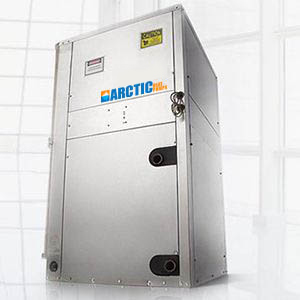Sizing Geothermal System
Sizing a Geothermal Heat Pump

This is perhaps one of the most asked questions. How do I size a geothermal heat pump? While we can assist you with this, we are not an engineering firm in the business of providing heat load calculations that will assist you with sizing. However, we can give you lots of advice when it comes to sizing. If you are in doubt contact a local contractor to help you with sizing your project.
New construction:
When building a new house, your builder, designer, or architect will have most likely done a heat load or heat demand calculation for you. A heat load calculation is a calculation that determines the loss of energy your house will experience based on the exterior dimensions and the insulation used in the home, as well as the number of windows. The build design parameters are then used in software that uses your geographic weather data to calculate the average coldest day. The software will then tell you the minimal size of a heater (BTU or Kw) you will need to maintain the comfort level in the house based on the average coldest day you can expect. All builders should be able to provide this for you. If you have designed your building from your own set of plans, then you are in luck! The internet is full of “Free Heat Demand Calculators”. Google it!!! Apple and Android also have Free Calculator Apps.
How exact do I have to be? Don’t worry too much if you are not exact on your heat demand calculation in most cases you can purchase a backup strip heater for under $500 that sits in your duct that can help your heat pump on those extreme conditions. So as long as you are close you will be fine. Don’t oversize your system too much as your compressor will short cycle. Bigger is not better! It is better for your system to run continuously and provide balanced heat than to turn on off constantly as it is oversized.
Old construction:
This is even easier than new constructions as you will already have an existing heater in place. This should be a good indication of the size of geothermal system you need. However, this assumes a heat demand study was done when sizing the unit. A lot of old buildings went with the assumption that bigger is better and oversized heating systems. Assuming your old heater is properly sized you can then use this to calculate the size of the new geothermal heater.
1 ton = 12,000 BTU = 3.5 Kw - So if your existing heater is 48,000 BTU then you would need to purchase as 4 ton GeoCool unit.
What do your neighbors have? This is a great way to size a system. Most homes in your neighborhood will be built at a similar time with similar construction so if you have a neighbor using geothermal then ask them how it is working. If they are satisfied with the size, then ask how many sq/ft their houses is. With this you can get a good comparison to what you would need based on your size of house.
Don’t waste heat! Any geothermal contractor will tell you to first invest in bringing your house up to standard insolation values. R20’s in the Walls and R-40 in the ceiling with good windows. This will be a wise investment and should always be done before you look at alternative heat sources including solar and geothermal.
Sizing the loop:
We can give you some good advice on this! There are many complicated calculations such as soil conditions moisture and geographic climate. However, HDPE pipe is relatively inexpensive and as such you will notice all our geothermal kits are oversized when it comes to the linear feet of ground loop pipe (700 per loop). This is where “bigger is better” having more pipe in the ground will provide better performance as you are able to cover more area to extract the ground’s retained heat energy. Ensuring the pipe is below the frost line is very important 6-8 feet will ensure you never have issues and never place pipe under driveway unless you go 10-12 feet as the frost will be pushed down.
All our system come with a dual oversized pump station to ensure they can deliver the proper pressure drop when using more pipe. While every home is different, in our experience our large loops sizes have always been able to provide our customers with great performance. If you are concerned about lack of space then you should contact a local installer to review your requirements and they may suggest you can use less pipe and still deliver the expected performance.
Slinky Loops versus straight loops- If you have the space then a straight return loop is better. However if space is limited the slinky loop will help you maximize the space while still providing good performance especially with an oversized loop. 30-36” slinky loops are best to cover more area.








